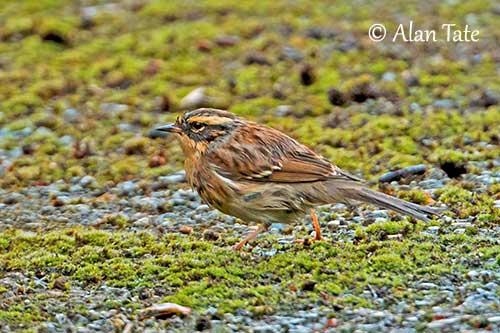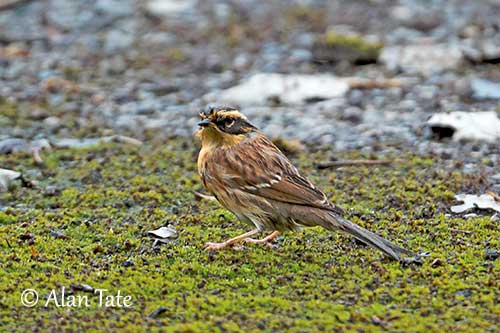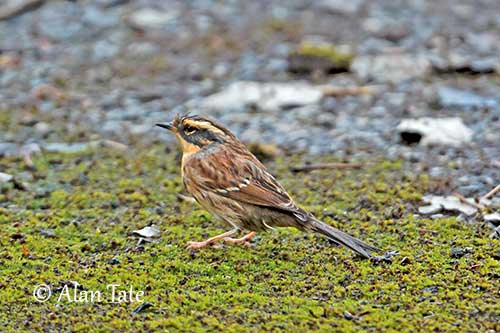
Fr :Accenteur montanelle
Ang: Siberian Accentor
All: Bergbraunelle
Esp: Acentor Siberiano
Ita: Passera scopaiola asiatica
Nd: Bergheggenmus
Sd: sibirisk järnsparv
Photographer:
Alan & Ann Tate
AA Bird Photography
Texte de Nicole Bouglouan
Sources :
HANDBOOK OF THE BIRDS OF THE WORLD Vol 10 by Josep del Hoyo-Andrew Elliott-David Christie - Lynx Edicions - ISBN: 8487334725
THE HANDBOOK OF BIRD IDENTIFICATION FOR EUROPE AND THE WESTERN PALEARCTIC by Mark Beaman, Steve Madge - C. Helm - ISBN: 0713639601
Ornithomedia - Le Web de l’Ornithologie
What Bird-The ultimate Bird Guide (Mitchell Waite)
Wikipedia, the free encyclopaedia
South Dakota Birds and Birding – (Terry L. Sohl)
Status and Occurrence of Siberian Accentor (Prunella montanella) in British Columbia.
By Rick Toochin and Don Cecile.
Siberian Accentor
Prunella montanella
Passeriformes Order – Prunellidae Family
INTRODUCTION:
The Siberian Accentor is a member of the third group in the family Prunellidae. Most of them have a pale supercilium and dark markings around crown, cheeks or throat. They occur in mountainous regions from Yemen to China, or are found along the northern limits of the Siberian coniferous forest.
The Siberian Accentor is a typical example of this group. It is migratory and spends the winter in SE Asia. Two subspecies share the range.
This species was first described in 1776 by Peter Simon Pallas, a German zoologist and botanist.
These pictures were taken recently in Great Britain, in October 2016, after an "influx" of this species in N Europe.
The Siberian Accentor is migratory and moves S to SE Asia after breeding. It leaves the breeding grounds in early September, but the southernmost breeding population moves later, mainly October/November. The return migration occurs between late March and April/May. They reach the northernmost breeding areas in June.
The Siberian Accentor performs short flights with rapid wingbeats, interspersed with short glides with the wings pulled to sides, involving rather undulating flight.
REPRODUCTION OF THIS SPECIES:
The Siberian Accentor breeds between June and August. The nest is placed between 50 cm and 8 metres above the ground, usually in a fork in low tree or hidden in thick shrub.
The cup-shaped nest is made with twigs, moss, leaves and animal hairs.
The female lays 4-6 pale blue eggs and incubates during 11-14 days. The chicks are fed by both parents during 10-15 days.
PROTECTION / THREATS / STATUS:
The Siberian Accentor is locally common to uncommon or rare depending on the range.
The European breeding population was estimated to number 100/500 breeding pairs in 2004, and the Russian population was estimated at 100/10,000 breeding pairs in 2009. These populations are suspected to be stable.
The Siberian Accentor is currently evaluated as Least Concern.
DESCRIPTION OF THE BIRD:
Biometrics:
Length: 14,5-17,5 cm
Weight: 23 g
The Siberian Accentor male of nominate race has brown upperparts with chestnut streaks on mantle and greyish-brown rump and tail. On the upperwing, two narrow pale wingbars are formed by the whitish tips of median and greater wing-coverts, more conspicuous at close range.
On the underparts, throat and breast are yellow-buff and flanks are buff, with dark chestnut streaks on breast and flanks. The central belly is creamy-white and becomes greyish on the vent.
On the head, the greyish-brown crown is edged black and contrast with the conspicuous long, broad, yellowish supercilium. The ear-coverts are blackish, mostly buff at rear. The neck sides are grey.
The bill has wide base that is mostly ochre on lower mandible, but the bill is blackish overall. The eyes are chestnut-brown with white half eyering below. Legs and feet are brownish-orange.


The female resembles male but she is duller, with duller brown plumage and less distinct streaking. She has less extensive black lateral crown stripes.
The juvenile is much duller, with less distinct facial pattern. The whitish supercilium is speckled brown. Crown and head sides are brownish. It lacks the grey patch on neck side. The upperparts lack the chestnut tinge, and below, there are small spots on throat sides and large, brown, triangular spots on breast.
SUBSPECIES AND RANGE:
The Siberian Accentor has two subspecies.
P.m. montanella breeds in extreme NE Europe and W Siberia, E to R. Lena. It is patchily distributed in S Russia, from upper R. Ob, upper R. Yenisey region and Altaï, E to Amur region.
P.m. badia breeds in NE Siberia from R. Lena E to Anadyrland, S to W shore of Sea of Okhotsk. This race is slightly smaller than nominate, with darker plumage and brighter colours overall.
Both populations winter in C and E China and Korea.
HABITAT:
The Siberian Accentor occurs from lowlands to mountain tree line. It frequents open, stunted coniferous and birch woodlands, and tangled thickets, especially willows near water. It is found in both open tundra and forest-tundra areas. It winters in montane forest.

CALLS AND SONGS: SOUNDS BY XENO-CANTO
The Siberian Accentor’s typical call is a high-pitched “tsee-ree-see”. The song recalls that of Dunnock, but it is more melodious, sweet and powerful. A second song, more buzzy, can be heard too.
BEHAVIOUR IN THE WILD:
The Siberian Accentor feeds on insects, spiders and other invertebrates during the breeding season. In autumn and winter, it also takes insects, but also consumes seeds and berries.
It forages on the ground, and may run over short distance when pursuing a prey. It pecks at soil, grass, dead leaves, but also forages in trees and bushes. It usually occurs single or in pairs, and sometimes in small groups.
The breeding behavior of the Siberian Accentor is poorly known. The Prunellidae usually produce two broods, and the present species probably lays two clutches in the southern part of the breeding range, but only one in the northern range.
We can suggest that the rich chestnut/black/yellowish plumage and the head pattern are enhanced by adapted postures during the displays, probably accompanied by songs.
They usually nests in small groups of 2-6 closely spaced pairs, but the nests are far apart in the race “badia”.

